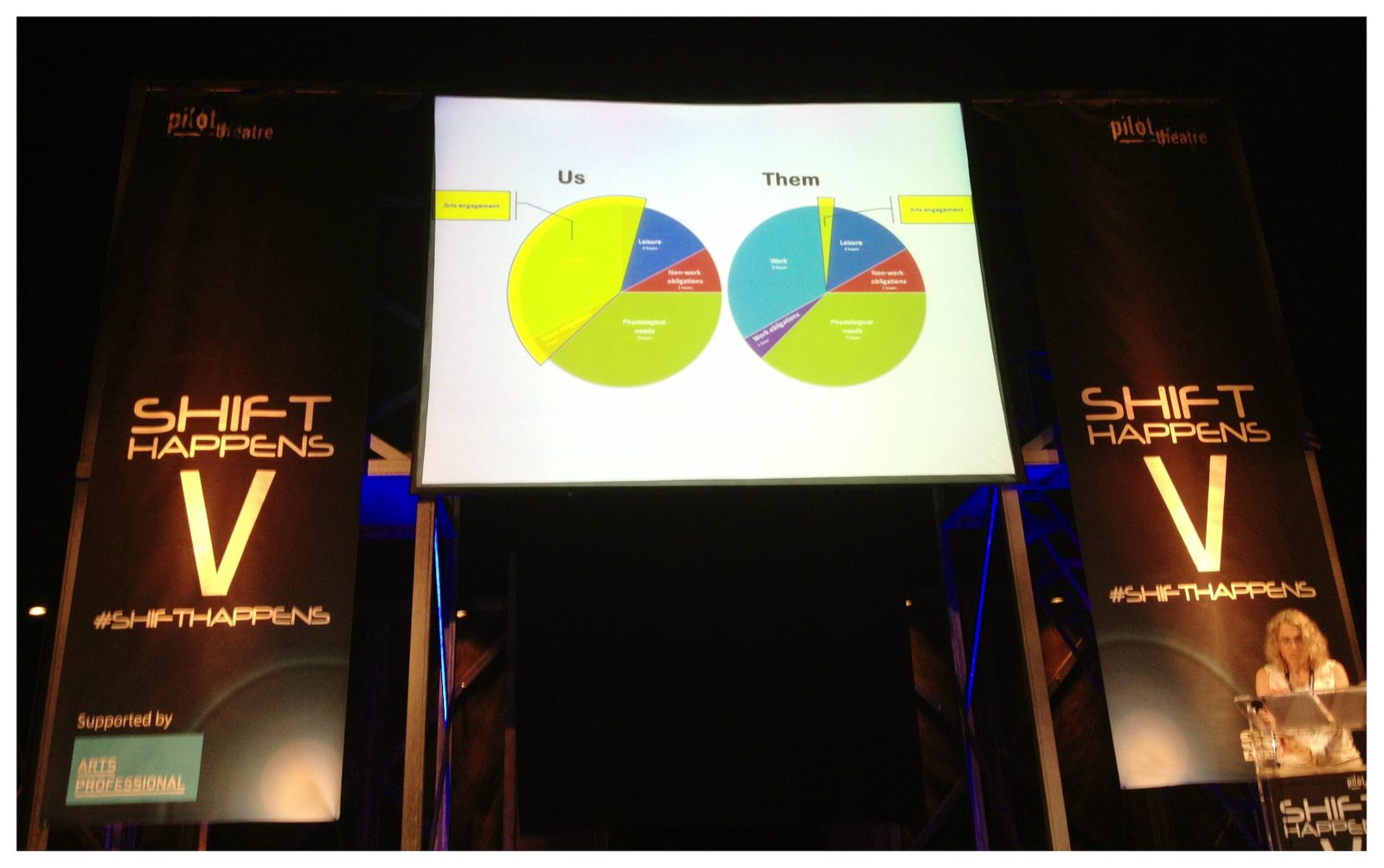ShiftHappens V - part 2
Published by Caron Lyon,
ReFocus - ReFrame - ReMix - ReRelect
From the 20 sessions on the schedule, all of which were inspirational several have stayed with me as the days pass.
Liz Hill was the fifth speaker of seven in the opening ReFocus session. Marcus's introduction to for Liz Hill was a key indicator about what the nature of ShiftHappens is said a lot about why the audience where gathered. "This is not about technology it's about people making shift happen." Liz Hill is Editor of industry magazine Arts Professional (ShiftHappens V media partner) began with her own story of how she entered the arts industry 25 years previously (late 80's) and met 'delightful' people who were passionate about the arts. 'never wore suits, started work at 10 and no good with numbers'. She questioned where an arts and cultural conscious comes from by looking at her life 25 yrs before. In her home life where mother an advocate of good education, enjoyed travel and processed a keen interest in politics. She had no arts consciousness. She does however read a newspaper along with 5 million, the Daily Mail. She drew a parallel with the arts and middle class paper The Guardian with a readership of ten times less every Saturday. Her father, a photographic practitioner would not have considered himself what today we call "a creative" or part of the creative industries. Her own arts and culture conscious took a while to develop.
Only when asked to deliver a university course about management specifically for music students did she begin to understand the value the arts had to offer. She shared her story because in line with the sessions theme Refocus she wanted to illustrate why the arts sector needs to refocus, to find a way to better resonate with a larger proportion of society who see the arts as 'nice but peripheral to their lives'.
How do we produce media compelling to this audience? The main stream media promote the commercial arts. Liz iterated the notion of this perception of a strong and thriving theatre industry. The annoyance of this self pitying industry hungry for funding, wanting more money, tales of poverty when ticket prices are so high or frequented by rich people who have money anyway. The arts are experience by painting classes, amateur dramatics but fail to understand why arts organisation were needed. Liz put if far more eloquently that I can reflect upon. I do hope Marcus releases the videos of the ShiftHappens V sessions.
Why is it that people in the Arts sector see art as fundamental to life when other see it as peripheral?
She continued to define leisure (quoting Stanley Parker) - time left over when other obligations have been attended to. Arts and Culture participation falls within leisure time for the majority of the population. The day can be divided in to five types of activity.
Work or Employment, Work obligations (travel even overtime), Non work obligations (eg. childcare and housework), Physiological needs (eg. eating, sleeping, washing) and what is then left over is leisure. In this 'leisure time'? Watching TV, gaming, sports and exercise, study, faith related interests, shopping, going to the pub and… the arts!
The Them and Us perspective looked like the slide in the photo below. with the extended slice being time available to consider arts participation. Is it any wonder that the majority of the populations perspective of the arts is different from those who work in the arts? A phenomenal insight. This image resonated with me. How do we address this?

The arts can be used to encourage people to see things differently. It's results may not be directly identified as 'art'. The industry is full of talent. The very impulse of creative expression is to make people see the world differently. How can we apply this 'creative genius' to our own predicament?
Liz illustrated her point with life saving ads, The Heart Foundation's Staying Alive cardiac massage featuring Vinney Jones. Which has consequently saved lives.
Uh oh, it looks like your embed code is broken.
And a Canne Film Festival award winning ad from Australia's Metro that reduced deaths on railway lines by 21% through a public advertising campaign showing the creative industries do indeed impact and initiate behavioural change. Produced media and artistic creations made by arts industry professionals using their skills to realise intended visions of the campaigners.
Uh oh, it looks like your embed code is broken.
Its wasn't just a catch tune but uploaded to YouTube 14th Novemebr 2012 and was view 28 million times in the first 2 weeks, has spawned 85 parodies online and has it's own page on wikipedia. It created a framework for discussion that usually takes years to impact.
So how can the value of the arts be conveyed to the public at large? The final example of successful public messages and a call to action from Liz was by showing the classic advert from Dunlop. "You'd be surprised how much you'd miss Dunlop"
Uh oh, it looks like your embed code is broken.
The call to Action was the announcement of a competition being launched in the autumn to create a short film to promote the value of the arts industry. I'll be looking out for that you can too at www.artsprofessional.co.uk
